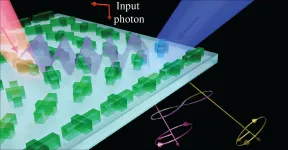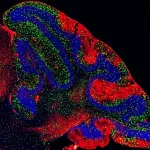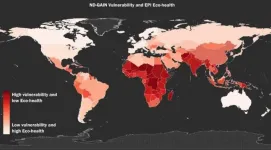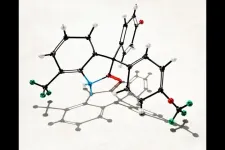INFORMATION:
Co-authors are Miles Macklin, Yashraj S Narang, Dieter Fox, Animesh Garg, Fabio Ramos, all of NVIDIA.
The full paper (open access) and blog post are available here: https://diff-cutting-sim.github.io/
New simulator helps robots sharpen their cutting skills
A simulation engine developed by University of Southern California and NVIDIA researchers predicts the forces acting on a knife as it cuts through soft materials, a capability that could have applications for safer food processing and surgical robotics
2021-07-21
(Press-News.org) Researchers from the University of Southern California (USC) Department of Computer Science and NVIDIA have unveiled a new simulator for robotic cutting that can accurately reproduce the forces acting on a knife as it slices through common foodstuffs, such as fruit and vegetables. The system could also simulate cutting through human tissue, offering potential applications in surgical robotics. The paper was presented at the Robotics: Science and Systems (RSS) Conference 2021 on July 16, where it received the Best Student Paper Award.
In the past, researchers have had trouble creating intelligent robots that replicate cutting. One challenge: in the real world, no two objects are the same, and current robotic cutting systems struggle with variation. To overcome this, the team devised a unique approach to simulate cutting by introducing springs between the two halves of the object being cut, represented by a mesh. These springs are weakened over time in proportion to the force exerted by the knife on the mesh.
"What makes ours a special kind of simulator is that it is 'differentiable,' which means that it can help us automatically tune these simulation parameters from real-world measurements," said lead author Eric Heiden, a PhD in computer science student at USC. "That's important because closing this reality gap is a significant challenge for roboticists today. Without this, robots may never break out of simulation into the real world."
To transfer skills from simulation to reality, the simulator must be able to model a real system. In one of the experiments, the researchers used a dataset of force profiles from a physical robot to produce highly accurate predictions of how the knife would move in real life. In addition to applications in the food processing industry, where robots could take over dangerous tasks like repetitive cutting, the simulator could improve force haptic feedback accuracy in surgical robots, helping to guide surgeons and prevent injury.
"Here, it is important to have an accurate model of the cutting process and to be able to realistically reproduce the forces acting on the cutting tool as different kinds of tissue are being cut," said Heiden. "With our approach, we are able to automatically tune our simulator to match such different types of material and achieve highly accurate simulations of the force profile." In ongoing research, the team is applying the system to real-world robots.
ELSE PRESS RELEASES FROM THIS DATE:
New quantum research gives insights into how quantum light can be mastered
2021-07-21
Los Alamos, N.M., July 21, 2021--A team of scientists at Los Alamos National Laboratory propose that modulated quantum metasurfaces can control all properties of photonic qubits, a breakthrough that could impact the fields of quantum information, communications, sensing and imaging, as well as energy and momentum harvesting. The results of their study were released yesterday in the journal Physical Review Letters, published by the American Physical Society.
"People have studied classical metasurfaces for a long time," says Diego Dalvit, who works in the Condensed Matter and Complex Systems group at the Laboratory's Theoretical Division. "But we came up with this new idea, which was to modulate in time and space the optical properties of ...
New framework applies machine learning to atomistic modeling
2021-07-21
Northwestern University researchers have developed a new framework using machine learning that improves the accuracy of interatomic potentials -- the guiding rules describing how atoms interact -- in new materials design. The findings could lead to more accurate predictions of how new materials transfer heat, deform, and fail at the atomic scale.
Designing new nanomaterials is an important aspect of developing next-generation devices used in electronics, sensors, energy harvesting and storage, optical detectors, and structural materials. To design these materials, researchers create interatomic potentials through atomistic modeling, a computational approach that predicts how these materials behave by accounting for their ...
A history of African dust
2021-07-21
In a recently published paper, a research team, led by University of Miami (UM) Rosenstiel School of Marine and Atmospheric Science Professor Emeritus Joseph M. Prospero, chronicles the history of African dust transport, including three independent "first" discoveries of African dust in the Caribbean Basin in the 1950s and 1960s.
Every year, mineral-rich dust from North Africa's Sahara Desert is lifted into the atmosphere by winds and carried on a 5,000-mile journey across the North Atlantic to the Americas. African dust contains iron, phosphorus and other important nutrients that are essential for life in marine and terrestrial ...
How a unique sponge 'goes with the flow' could improve man-made structures
2021-07-21
BROOKLYN, New York, Weekday, Month xx, 2021 - The remarkable structural properties of the Venus' flower basket sponge (E. aspergillum) might seem fathoms removed from human-engineered structures. However, insights into how the organism's latticework of holes and ridges influences the hydrodynamics of seawater in its vicinity could lead to advanced designs for buildings, bridges, marine vehicles and aircraft, and anything that must respond safely to forces imposed by the flow of air or water.
While past research has investigated the structure of the sponge, there have been few studies of the hydrodynamic fields surrounding and penetrating the organism, and whether, besides improving its mechanical ...
Team streamlines neural networks to be more adept at computing on encrypted data
2021-07-21
BROOKLYN, New York, Wednesday, July 21, 2021 - This week, at the 38th International Conference on Machine Learning (ICML 21), researchers at the END ...
Dynamic heart model mimics hemodynamic loads, advances engineered heart tissue technology
2021-07-21
Efforts to understand cardiac disease progression and develop therapeutic tissues that can repair the human heart are just a few areas of focus for the Feinberg research group at Carnegie Mellon University. The group's latest dynamic model, created in partnership with collaborators in the Netherlands, mimics physiologic loads on engineering heart muscle tissues, yielding an unprecedented view of how genetics and mechanical forces contribute to heart muscle function.
"Our lab has been working for a long time on engineering and building human heart muscle tissue, so we can better ...
Researchers find immune component to rare neurodegenerative disease
2021-07-21
UT Southwestern researchers have identified an immune protein tied to the rare neurodegenerative condition known as Niemann-Pick disease type C. The END ...
New study confirms relationship between toxic pollution, climate risks to human health
2021-07-21
For more than 30 years, scientists on the U.N.'s Intergovernmental Panel on Climate Change have focused on human-induced climate change. Their fifth assessment report led to the Paris Agreement in 2015 and, shortly after, a special report on the danger of global warming exceeding 1.5 degrees Celsius above pre-industrial levels. The Nobel Prize-winning team stressed that mitigating global warming "would make it markedly easier to achieve many aspects of sustainable development, with greater potential to eradicate poverty and reduce inequalities."
In a first-of-its-kind study that combines assessments of the risks of toxic emissions (e.g., fine particulate matter), ...
Exoskeletons have a problem: They can strain the brain
2021-07-21
COLUMBUS, Ohio - Exoskeletons - wearable devices used by workers on assembly lines or in warehouses to alleviate stress on their lower backs - may compete with valuable resources in the brain while people work, canceling out the physical benefits of wearing them, a new study suggests.
The study, published recently in the journal Applied Ergonomics, found that when people wore exoskeletons while performing tasks that required them to think about their actions, their brains worked overtime and their bodies competed with the exoskeletons rather than working in harmony with them. The study indicates that exoskeletons may place enough burden on the brain that potential benefits to the body are negated.
"It's almost like dancing with a really bad partner," said ...
New approach eradicates breast cancer in mice
2021-07-21
CHAMPAIGN, Ill. -- A new approach to treating breast cancer kills 95-100% of cancer cells in mouse models of human estrogen-receptor-positive breast cancers and their metastases in bone, brain, liver and lungs. The newly developed drug, called ErSO, quickly shrinks even large tumors to undetectable levels.
Led by scientists at the University of Illinois Urbana-Champaign, the research team reports the findings in the journal Science Translational Medicine.
"Even when a few breast cancer cells do survive, enabling tumors to regrow over several months, the tumors that regrow remain completely ...
LAST 30 PRESS RELEASES:
Norbert Holtkamp appointed director of Fermi National Accelerator Laboratory
New agentic AI platform accelerates advanced optics design
Biologists discover neurons use physical signals — not electricity — to stabilize communication
Researchers discover that a hormone can access the brain by hitchhiking
University of Oklahoma researcher awarded funding to pursue AI-powered material design
Exploring how the visual system recovers following injury
Support for parents with infants at pediatric check-ups leads to better reading and math skills in elementary school
Kids’ behavioral health is a growing share of family health costs
Day & night: Cancer disrupts the brain’s natural rhythm
COVID-19 vaccination significantly reduces risk to pregnant women and baby
The role of vaccination in maternal and perinatal outcomes associated with COVID-19 in pregnancy
Mayo Clinic smartwatch system helps parents shorten and defuse children's severe tantrums early
Behavioral health spending spikes to 40% of all children’s health expenditures, nearly doubling in a decade
Digital cognitive behavioral treatment for generalized anxiety disorder
Expenditures for pediatric behavioral health care over time and estimated family financial burden
Air conditioning in nursing homes and mortality during extreme heat
The Alps to lose a record number of glaciers in the next decade
What makes a good proton conductor?
New science reporting guide published for journalists in Bulgaria
New international study reveals major survival gaps among children with cancer
New science reporting guide published for journalists in Turkey
Scientists develop a smarter mRNA therapy that knows which cells to target
Neuroanatomy-informed brain–machine hybrid intelligence for robust acoustic target detection
Eight SwRI hydrogen projects funded by ENERGYWERX
The Lundquist Institute and its start-up company Vitalex Biosciences Announces Strategic Advancement of Second-Generation fungal Vaccine VXV-01 through Phase 1 Trials under $40 Million Competitive Con
Fine particles in pollution are associated with early signs of autoimmune disease
Review article | Towards a Global Ground-Based Earth Observatory (GGBEO): Leveraging existing systems and networks
Penn and UMich create world’s smallest programmable, autonomous robots
Cleveland researchers launch first major study to address ‘hidden performance killer’ in athletes
To connect across politics, try saying what you oppose
[Press-News.org] New simulator helps robots sharpen their cutting skillsA simulation engine developed by University of Southern California and NVIDIA researchers predicts the forces acting on a knife as it cuts through soft materials, a capability that could have applications for safer food processing and surgical robotics




